Web Exclusive: Looking back on the distressful 12 years in Takae through photos
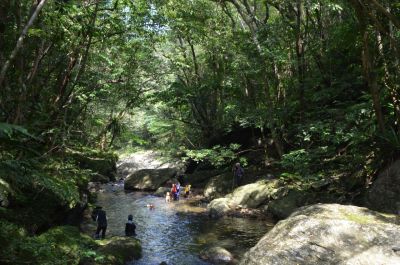
October 11, 2019 Ryukyu Shimpo
By Yoko Tabuki
Imagine a highland with spectacular views of lush green forests and the great Pacific Ocean, where during the day, the Okinawa rail and the Okinawa woodpecker can be heard, while at night, stars fill the sky. That’s Takae in a nutshell. Takae is a small town with a population of 100, located at the edge of Higashi Village, in the nature-rich northern region of Okinawa’s main island. Many of its residents make a living off of pineapple farming, making Takae the top pineapple producer in Japan. October 11 marked two years to the day since a CH-53E heavy-lift helicopter, based at U.S. Marine Corps Air Station Futenma, made an emergency crash-landing in the tranquil district of Takae before bursting into flames. How did a U.S. military helicopter end up in this neighborhood enclosed in nature? Takae’s embroilment in the U.S. military base issues in Okinawa does not stop with this incident. We look back on the twelve years of distress experienced by Takae residents, including episodes pertaining to the construction of helipads, through past articles and photos.
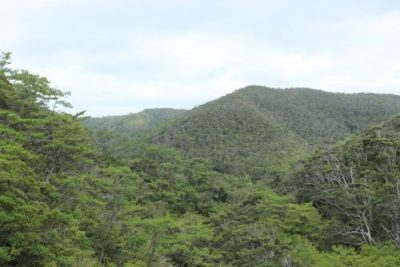
The lush green landscape of Yanbaru, Higashi Village, photographed in 2013.
The CH-53E helicopter made an emergency landing in a pasture just 200 meters from a private residence in Takae. The pasture and the adjacent home belonged to Akira Nishime, 66. At the time, his wife, Mieko, told the Ryukyu Shimpo during an interview: “We could have died.” It was a miracle that no one was out in the pastures, which was nearing hay harvest.

The Futenma-based CH-53E heavy-lift helicopter burst into flames after crash-landing in a pasture on October 11, 2017 in Takae, Higashi Village. The aircraft pictured in the sky is attacking the fire with buckets of water from above.
A community surrounded by U.S. military bases
Takae is encircled by U.S. military bases. The forests surrounding the district itself is used as training grounds by the military.
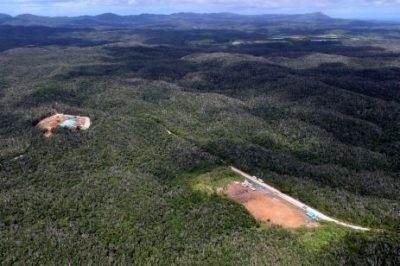
The Northern Training Area (NTA), also known as the Jungle Warfare Training Center (JWTC) photographed by a drone in October 2016 in Higashi.
The U.S. military converted 7,543 hectares of land into the Northern Training Area (NTA) after acquiring Okinawan lands in 1957. According to the prefecture’s website, the NTA enables guerilla training, and as of 2019, contains 21 helicopter landing zones within it. During the Vietnam War, the U.S. military created a “Little Vietnam” in the NTA, and in some cases made Takae locals play Vietnamese roles. Witness testimonies indicate that defoliants, including highly toxic dioxins, were used in these forests.
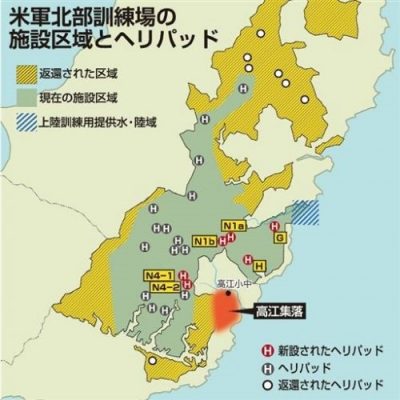
In December of 1996, the Special Action Committee on Okinawa (SACO) agreement established that 3,987 hectares of land, a majority of the NTA, would be returned to Okinawa. However, one condition of the agreement involved relocating six helicopter landing zones from Kunigami, which was to be returned to Okinawa, to Takae district. Like the relocation of Futenma base to Henoko, Nago City, the decision to relocate a U.S. military facility within the prefecture was forced onto the local residents.
The Japanese government sues the citizens of Takae
Takae locals strongly opposed building new helipads for its relocation. Numerous resolutions were passed to demand the construction plans be withdrawn. However, one early morning in July 2007, the Okinawa Defense Bureau commenced construction work. Takae residents staged a sit-in to stop the heavy trucks from bringing in construction materials.
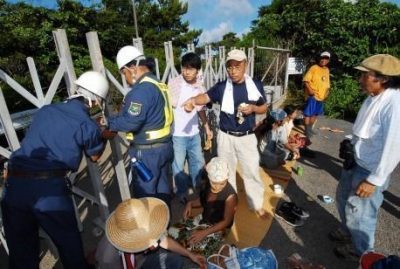
Security personnel proceed to open the gates at Takae around 8:02 a.m. on July 3, 2007, even as the locals stage a sit-in at the site.
In 2008, the Ministry of Defense and the Okinawa Defense Bureau filed a provisional injunction at the Naha District Court to restrain 15 Takae residents, including an 8-year-old (the child was later dropped from the injunction) from blocking traffic at the site. Many experts criticized this “strategic lawsuit against public participation” (also known as “SLAPP”) for impeding on the freedom of expression. The suit escalated into a court case, which resulted in a total defeat for Takae locals, when the Supreme Court decided to reject their appeal.
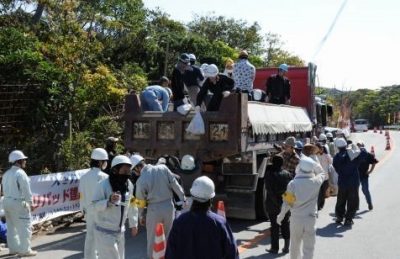
Tensions arise as protestors surround a dump truck in an attempt to obstruct the construction work of the helipad in Takae, Higashi Village. Photographed around 2 p.m. on February 2, 2011.
The government forced through construction work while residents continued to stage sit-ins day and night. Construction of two helipads in the Southside (the N4 area) was completed by 2014. After 2016, construction of four helipads in the Northside (two sites in N1, one each in Gt and H areas) resumed.
Construction work resumes
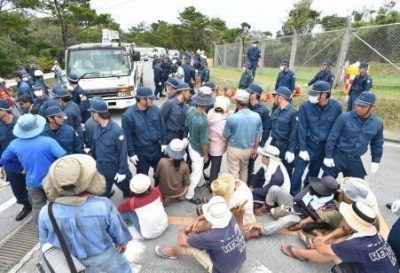
The riot police remove locals protesting the delivery of construction materials. Photographed at the NTA main gates in Takae, Higashi Village, at around 1:22 p.m. on July 11, 2016.
Construction work at the helipad site resumed the morning after the Upper House elections, on July 11, 2016. Just past 6 a.m., the government deployed 100 riot police and 20 private guards. The stare down between the two sides began after 60 locals from within and without Takae district rushed to the gate. As this conflict intensified over the next five months, numerous incidents erupted—Several locals were arrested, riot police physically encircled some reporters, blocking their newsgathering, and made discriminatory comments against Takae residents.

Riot police removing the protesting locals at Takae, Higashi Village, at 10:54 p.m. on July 21, 2016.
Even so, the government resumed construction work, and all six helipads were completed by December 2016. Subsequently, 4,010 hectares of the NTA was returned to Japan. The Japanese government emphasized how this reduced the burden placed upon Okinawa as a military host. Simultaneously, the government planned to add the returned land to the Yambaru National Park and re-nominate the area for UNESCO’s World Natural Heritage Site.
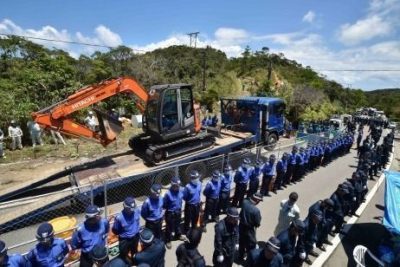
The Okinawa Defense Bureau resuming construction of a helipad around 1:30 p.m. in Takae, Higashi Village, on July 22, 2016.
Then the helicopter came down
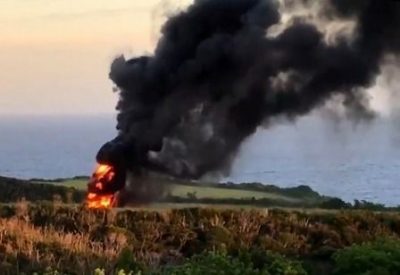
A Futenma-based CH-53 heavy-lift helicopter burst in flames after making a crash-landing in a pasture in Takae, Higashi Village, after 6 p.m. on October 11, 2017. (Photograph provided by a Ryukyu Shimpo reader.)
When the heavy-lift helicopter was forced to land in a pasture located in the Kuruma neighborhood of Takae around 5:20 p.m. on October 11, 2017, the construction of the six helipads in Takae district was completed, and two of the helipads in the Southside were already operational. The CH-53 was wrecked, but there were no injuries to the residents or crew.
The scene of the accident was soon illuminated and flooded with flashing red lights, as fire trucks and police cars drove in and out. The town was thrown into confusion as the smell of burning fuel filled the air.

The pasture belonged to Akira Nishime and his family, who lived nearby. When the accident occurred, Nishime’s wife, Mieko, was mowing the lawn around their home. Mieko climbed on to a tank in the garden and saw black smoke rising from the pasture after her father-in-law, Kiyoshi, called out to her. Kiyoshi was inside a pig pen located just 100 meters from where the helicopter landed.
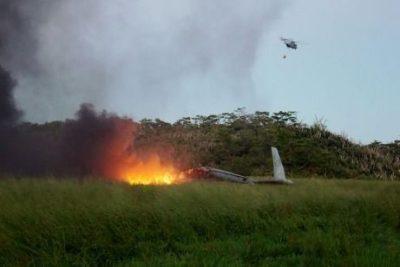
Flames engulf the CH-53E after it made an emergency-landing in a pasture in Takae, Higashi Village, around 6:15 p.m. October 11, 2017.
The Nishime family makes a living farming grass hay for cows and goats. Peak harvest was fast approaching at the time of the accident. Subsequently, the Okinawa Defense Bureau decided to compensate the Nishimes until the crop quality recovered to normal levels, but the compensation promised by the government was never paid out to the family. Nishime is worried: “It’s been radio silence. It’s like the government forgot about us.” He revealed that U.S. military aircrafts “still fly over private fields and residences, as if nothing ever happened. Not a thing has changed in the past two years.”
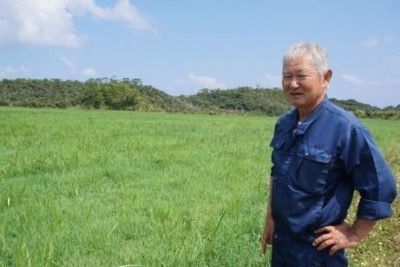
On October 8, 2019, Akira Nishime stands in the same pasture in Takae, where the helicopter crash-landed two years prior. He is uncertain he will ever receive the promised compensation.
The U.S. military took soil from the scene, just as it had in 2004, when one of its helicopters crashed on the Okinawa International University campus. Some of the soil was disposed of outside Okinawa, without notifying the Japanese government. Backlash from Okinawans mounted, as evidence critical to the investigation of this accident was lost.
Life goes on
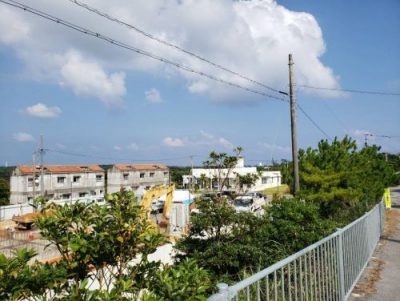
The neighborhood of Takae photographed on October 8, 2019.
Few reporters and non-villagers come to Takae now, compared to a couple years ago, when large-scale protests had erupted over the CH-53E accident combined with the Takae helipad construction. At a glance, it seems as though Takae residents have returned to living a tranquil life. However, since February 2015, when helipads were provided to the U.S. military in the N4 area on the Southside, sound pollution levels have been intensifying. During 2014, the Defense Bureau recorded 1,280 instances in which noise levels exceeded 60 decibels (7 a.m. – 7p.m.) on a cow path, whereas in 2015, after the helipads were provided, the number tripled to 3,686 instances. FY 2018 marked a record high, at 5,327 instances. Military aircrafts fly in the dead of the night, which continues to disrupt the residents from getting a quiet night’s sleep.
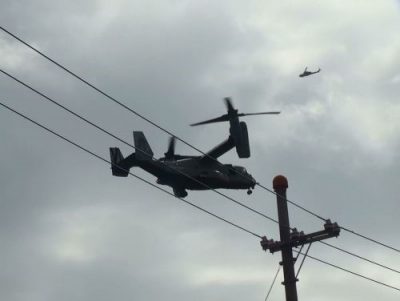
A U.S. military Osprey and helicopter both training above Highway 70, at 12:09 p.m. on January 1, 2017, near the NTA N4 area in Takae, Higashi Village. (Photograph provided by Akino Miyagi)
Just in September this year, the U.S. military mistakenly landed a helicopter 11 kilometers away from Takae, in the neighboring village of Yasuda, Kunigami—an area which was returned to Japan from the U.S. The Japanese government stressed that the return of NTA land from the U.S. has reduced the burden on Okinawa, but in reality, the locals are placed in constant danger.
During the month of September, Takae residents were busy preparing for a harvest festival for the first time in ages. The locals gathered every day to rehearse, as if to make up for the previous festival, which was cancelled due to the confusion surrounding the helipad construction. The population of Takae has aged, and shrunk by 50, in the past six years. Kumiko Nakamine, 69, district leader of Takae, watched over the dance practice for the classic Okinawan number, Kagiyade-fuu, and said in a low voice, “Kagiyade-fuu is typically danced by a pair of middle-school students, but currently, there is only one middle-school student in Takae. So, the other part went to an elementary-school student.”
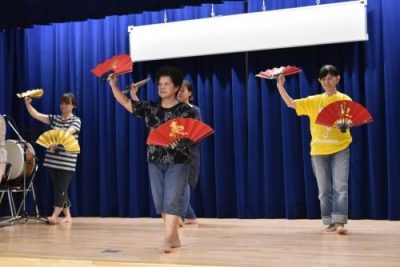
In preparation for the first harvest festival in six years, the locals practice at the Takae Community Center located in Higashi Village on September 9, 2019.
Regardless of its small population, Takae’s harvest festival was a success, as both long-time Takae residents and recent transplants new to Okinawa, came together.
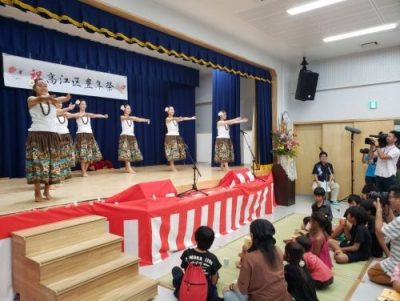
The harvest festival photographed on September. 13, 2019, at the Takae Community Center in Higashi Village.
The highlight of the festival was the “Pine-taro,” an original play put on by the young men’s association. The play’s main character “Pine-taro,” along with other characters, including an Okinawa rail and a boar, stop the antagonist contractor, wishing to destroy Takae’s nature in the name of development. In the final scene, the town proposes an economic development plan, which utilizes its abundant nature, and all the characters become friends in a happy ending.
Yoshi Nishime, 90, born and raised in Takae, summed up the event in two words: “The best.”
Takae resident, Takashi Ishihara, 49, remembered the distress Takao residents endured over the years and said, “A lot has happened [in Takae],” then emphasized that, “even so, we will again assure each other of our connectedness.”
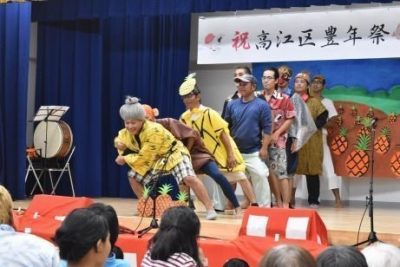
The young men’s association takes the stage at the harvest festival on September 13. The audience applauds, as the group performs their original play, the “Pine-taro.”
(English translation by T&CT and Monica Shingaki)
Previous Article:Miyakojima residents protest construction of GDSF ammunition depot
Next Article:Rope breaks for the first time at annual Great Tug-of-War
[Similar Articles]
- Burned-out U.S. Marine CH-53E helicopter casts a disturbing image after a forced landing in Takae
- U.S. Marine CH-53 helicopter bursts into flames after landing in civilian areas of Takae
- US military carries out Osprey training at new helipad in Takae for the first time
- Higashi Village Assembly demands nearby U.S. military helipads be removed, claiming, “The training are increasing, and residents live in fear”
- Takae residents protest against Japanese government agreeing to provide land for US helipads before returning region’s land occupied by US military
 Webcam(Kokusai Street)
Webcam(Kokusai Street)


